> Aaron RodgersBrett FavreNFL
> Aaron RodgersBrett FavreNFL

By Scott Kacsmar
From Joe Burrow’s calf to Aaron Rodgers’ Achilles, injuries to NFL quarterbacks have already impacted the 2023 season. It is especially clear in the AFC race with the Bengals and Jets both sitting at 1-3 after having the third and fourth-highest Super Bowl odds in the conference going into Week 1.
There have been plenty of other injuries around the NFL this season, but nothing moves point spreads, or playoff odds, and has a higher impact on teams than an injury at the quarterback position. In fact, you can explain 70% of the variation in NFL team records just from how efficient the passing offense is.
But has the quarterback position become so relied on that it is harder to get one player through a 17-game season (plus a playoff run) without them succumbing to injury at some point? Has the evolution of quarterbacks becoming more mobile, leading to more scrambles, designed runs, and sacks, only made it more likely that they get injured during a game?
We are looking at the injury history for this season’s starting quarterbacks, emerging trends in quarterback usage around the league, and how this stacks up to previous generations of signal callers.
We have some charts to show the injury history for every active starting quarterback, including Zach Wilson. Let’s face it, outside of 4 snaps of Aaron Rodgers before dreams turned into nightmares, Wilson has been New York’s intended starting quarterback since 2021.
These injuries are the only ones that led to a quarterback missing future starts due to the injury. This does not include something like Derek Carr injuring his shoulder in Green Bay in Week 3 and exiting the game in the third quarter, because he did start the following game. Maybe he should have sat, and maybe a future update will include “games not finished due to injury” to account for those situations, but for now, these are only injuries that cost a quarterback full games.
We start with the only five quarterbacks to miss the equivalent of a full season (17+ games) to injury.
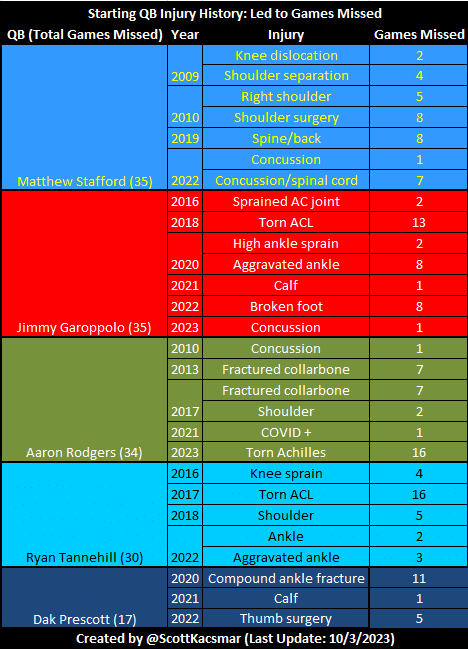
The next 7 quarterbacks have all had at least 4 different injuries that knocked them out for games:
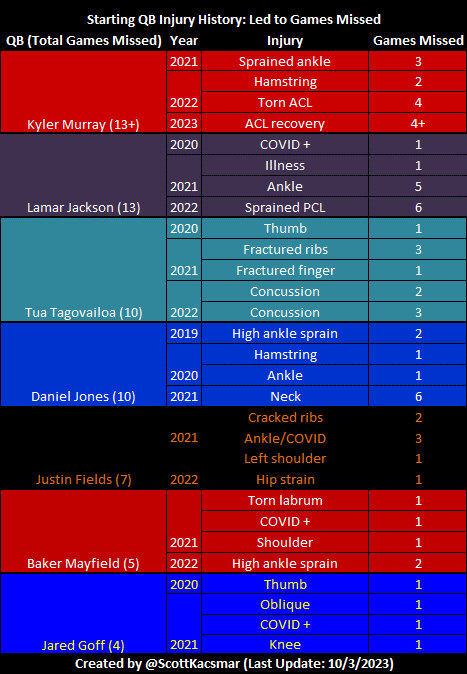
The other 21 quarterbacks are the fortunate bunch that have only had a couple of injuries at most.
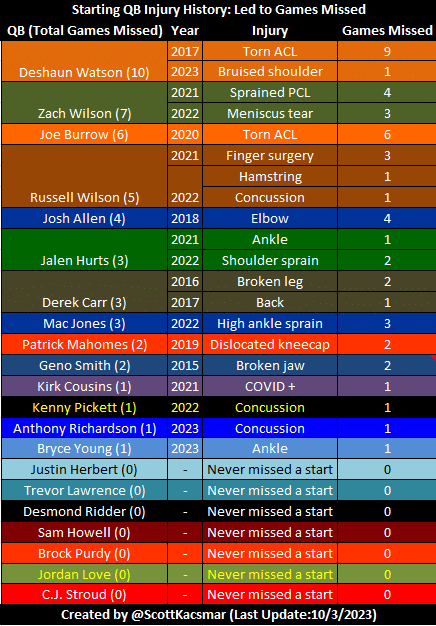
That just leaves Joe Burrow, who might compare best here to Watson of all people. Both tore their ACLs in their rookie seasons. But Watson just had his second injury this past week when he decided to sit out the Baltimore game with a bruised shoulder despite getting medical clearance to play.
Should Burrow have done the same with his calf injury suffered in late July in training camp? If he had shut things down for September and allowed the Bengals to sign a veteran to start those games, maybe things would be looking a lot better right now. Instead, Burrow ranks 29th in QBR and his Bengals are 1-3 with an offense that ranks 31st in scoring and dead last in yards and yards per play.
The quarterback position has no doubt changed with mobile passers replacing the more stationary pocket passers. This will only continue when someone like USC’s Caleb Williams enters the NFL.
But there is also no denying that we experienced a golden age of quarterbacks in the 2000s and 2010s. With countless passing records, Super Bowls, and MVP awards on their resumes, we have seen many of the game’s all-time greats retire in the last decade.
Here is a look at the injury histories, just like we did above with the active players, for 10 legends from the last two decades:
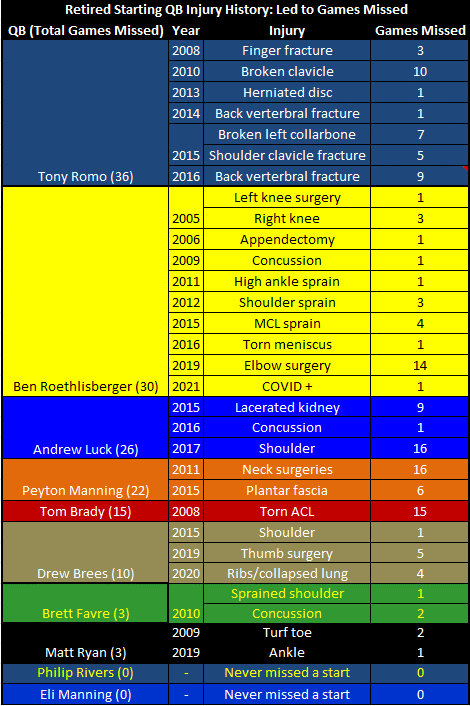
Philip Rivers and Eli Manning were traded for each other on draft day in 2004, and despite 474 starts between them, both incredibly never missed a start to injury. Of course, the bittersweet part of Rivers’ streak is that he played the biggest game of his career (2007 AFC Championship Game in New England) on a torn ACL suffered a week earlier in Indianapolis.
The only quarterback with a longer consecutive starts streak than Rivers and Eli was Brett Favre at 321 games (297 regular season, 24 playoffs), a record that will never be broken. Make all the Favre jokes about his off-field life that you want, but this record is never leaving his name.
Rivers and Eli aside, the only other quarterback to come within even 150 games of Favre’s record was Peyton Manning, who holds the record for most consecutive starts to begin a career at 227 games (his entire Indianapolis tenure). But four neck surgeries in 2011 led to later problems like a bad quad in 2014 and his plantar fascia issue in 2015 that almost ended his career before he won that second Super Bowl with Denver.
Tom Brady’s status as the LOAT (Luckiest of All Time) is secure as he only had one major injury in 23 seasons when Bernard Pollard tore his ACL on a hit in Week 1 of the 2008 season. Brady used to be listed as probable with a shoulder injury for years in New England as Bill Belichick loved to manipulate the weekly injury reports. Brady finished with three different consecutive starts streaks of 128 (Pollard in 2008), 126 (Deflategate suspension in 2016), and 126 games (retired). That is almost as insane as Favre’s 321-game streak.
Drew Brees was incredibly durable with one game missed to injury in his first 18 seasons before a couple of notable issues in his final two seasons with the Saints. Similarly, Matt Ryan only missed 3 starts due to two minor injuries, and he was one of six quarterbacks to have a streak longer than 140 starts.
On the other side of the coin, Tony Romo and Ben Roethlisberger had a long list of injuries that led to 30-plus starts missed. Both liked to extend the play more than their peers, and they paid for it at times. Had Romo not been injured so often, the Hall of Fame would be a realistic possibility for him.
Andrew Luck was also on a Hall of Fame path before injuries in 2015-17 cost him 26 games. He played even more aggressively than Romo and Roethlisberger, and he only returned for one more stellar season in 2018 before shocking everyone by retiring just shy of his 30th birthday in 2019.
We just went over the injury history of 43 quarterbacks from the 21st century. We mentioned the records for consecutive starts by a quarterback, and if you look at that list, it is dominated by pocket passers. You don’t see anyone like Michael Vick, Cam Newton, Randall Cunningham, Steve Young, or John Elway on that list.
Russell Wilson starting the first 165 games of his career in Seattle, the fifth-longest streak ever, is an outlier. But even Wilson was not someone who took on a lot of contact in the open field. He was good at sliding and getting out of bounds, but he no doubt took a lot of sacks that will likely shorten his career length.
That is why it is amusing to see that Josh Allen has the longest active streak at 83 consecutive starts, which ranks as the 22nd-longest streak in history. His playing style is anything but conservative – Allen will try hurdling a defender 8 yards short of the first down marker. We’ll see how long the new odds-on favorite for MVP in 2023 can keep that going.
Impact of 17 Games
Logically speaking, there should be more quarterback injuries now. The NFL moved to a 17-game season in 2021, making it harder to last every game without getting injured. Some teams may also want to use Week 18 to give a third-string quarterback a shot at starting like the Commanders did with rookie Sam Howell last year. He might not be their starter right now if they didn’t do that last season.
Let’s look at the data in the 32-team era since 2002 for how many unique starting quarterbacks there are, how many started every game, and how many teams had to start at least 3 quarterbacks.
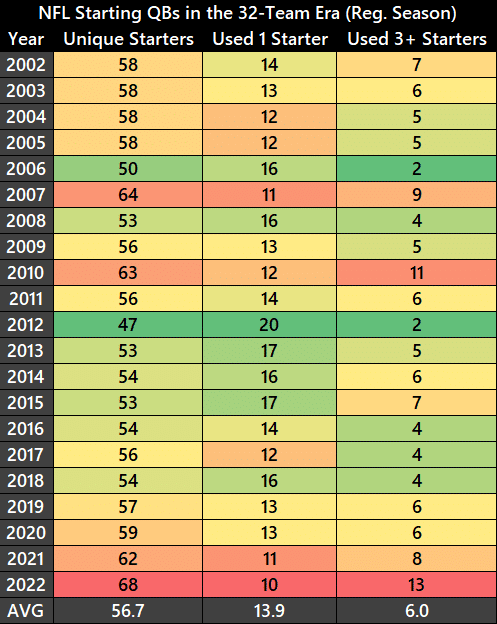
It looks like 17 games is having an impact already. The last two seasons are the only time when the league needed over 60 unique starters in back-to-back years. The 68 unique starters in 2022 were the most since 2002, replacing the 64 used in 2007. So far in 2023, 5 teams have used multiple starters, but we are only going into Week 5.
Only 10 teams used the same starting quarterback in every game last year, the fewest in any season since 1999 had 8. That includes the Bills and Bengals, who only played 16 games due to the Damar Hamlin incident cancelling their game.
A whopping 13 teams used at least 3 different starters last year, more than double the average in a season (6.0). This had a direct impact on the playoffs too as a couple of third-string rookie quarterbacks (Skylar Thompson for Miami and Brock Purdy for San Francisco) had to start playoff games. Backup Tyler Huntley also started in place of Lamar Jackson for the Ravens, meaning three backups started playoff games. Only Purdy won some games for his team as the others lost in the AFC’s wild card round.
Since 2002, there was only one other season where multiple teams had to start a backup quarterback in the playoffs with their starter unavailable. It was in 2016 when Connor Cook (Raiders) and Matt Moore (Dolphins) started for injured veterans Derek Carr and Ryan Tannehill. They both lost in the wild card round.
Even last year’s Super Bowl between No. 1 seeds with 14-3 records and the top two MVP vote getters was in doubt at various points. Jalen Hurts had a shoulder injury in Week 15 that cost him two games, but he was able to return in Week 18. Patrick Mahomes suffered a high ankle sprain during the second possession of the divisional round against Jacksonville, causing him to miss the rest of the quarter before he returned. He aggravated it in the next two games but was still able to pull off a key scramble on game-winning drives against the Bengals and Eagles to win his second Super Bowl.
But not everyone can play injured as well as Mahomes, who was injured on an innocuous play against Jacksonville. That’s the tough part with injuries. They can happen on any snap, and they can be completely random. If quarterbacks have the ball in their hands more often and in more compromising positions like runs, then they will be open to more opportunities for injuries.
Changes in Quarterback Usage
After a poor Week 1 for offenses, we looked at the historic number of young and inexperienced starting quarterbacks in the NFL in 2023. One of the big problems for young quarterbacks is taking sacks. They tend to need time to catch up to the speed of the game and to process things faster. But when so many of these young quarterbacks can run now, that mobility also can lead to bad sacks being taken. If you don’t believe me, watch Sam Howell and Justin Fields play the position this Thursday night.
So far, the league-wide sack rate in 2023 is 7.2%, which would be the highest since the 1998 season. Most seasons in the last 25 years have been in the range of 6.1-6.7%. However, if you track team sacks per game over time, things have not changed that dramatically. For instance, teams averaged 2.31 sacks per game in 1988, 2.51 sacks per game in 1998, 2.02 sacks in 2008, and 2.50 sacks in 2018.
The more dramatic change is happening with quarterback runs in the last 5 years. We tracked both the number of sacks and quarterback runs per team game since 1988, which was the start of a non-stop run of 16 or 17-game seasons without any strikes.
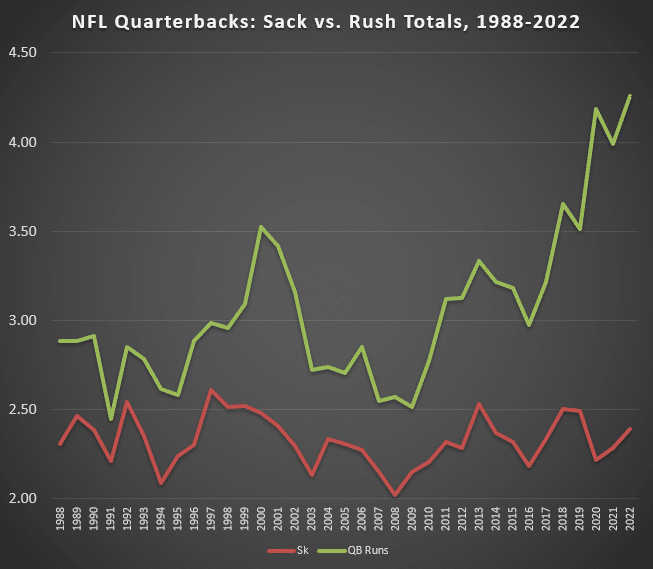
Again, sacks have been consistent, but there is triple the variance with how often quarterbacks run the ball. You can see a spike in the 2000 season when teams averaged 3.53 quarterback runs per game. That was a changing of the guard era after many Hall of Fame quarterbacks retired in the late 90s such as Jim Kelly, John Elway, Dan Marino, and Steve Young. A new group of athletic scramblers emerged with Daunte Culpepper, Rich Gannon, Steve McNair, Donovan McNabb, Jeff Garcia, and Kordell Stewart leading the way.
But even the arrival of Michael Vick a few years later did not sustain this as the pocket passers fired back with Peyton Manning, Tom Brady, Drew Brees, Ben Roethlisberger, etc. soon taking over the league. From 2003-10, quarterbacks never averaged more than 2.85 runs per game.
Another shift happened in 2011 with the arrival of more athletic quarterbacks and the usage of the read-option in the NFL. This was when Cam Newton, Russell Wilson, Robert Griffin III, and Colin Kaepernick were the talk of the future of the league. In every year since 2011 except for 2016, quarterbacks have averaged over 3.0 runs per game.
But things increased again in 2018 with the arrival of Lamar Jackson in Baltimore, who has rewritten the possibilities of what a quarterback can do running the ball in this league. The average number of quarterback runs jumped to its highest ever at 3.65 in 2018. With players like Allen, Hurts, and Fields following Jackson’s lead, that number hit 4.19 in 2020 and a new high of 4.26 in 2022. It has only been four weeks in 2023, but we are currently at 4.53 quarterback runs per team game.
From 1988 to 2017, teams averaged 2.92 quarterback runs per game. That is up a full play to 3.92 since 2018. Last year, Hurts became the first quarterback to run the ball 200 times in a season (playoffs included). Not everyone is going to run their quarterback like this, and the Eagles are seemingly the only team capable of doing the Tush Push correctly. But quarterbacks who can run with the ball and make things happen that way are on the rise, and they are becoming a necessity to deal with these elite pass rushers who can get into the backfield so quickly like T.J. Watt, Myles Garrett, Micah Parsons, and Nick Bosa.
Concussion Protocol
Finally, another change worth noting in today’s NFL is the new concussion protocol that was put in place last year after the Miami Dolphins mishandled Tua Tagovailoa’s health. He looked visibly concussed in a Week 3 game against Buffalo, he returned to finish it, then he started 4 days later in Cincinnati where he was concussed again. It was a scary scene for Tua and an ugly scene for the NFL as he should not have been playing so soon.
That led to the NFL implementing a new concussion protocol, and there had already been progress in getting third-party evaluators to handle those tests in recent years. But the big addition in 2022 to the protocol was adding “ataxia” as a no-go symptom. If a player looks unstable, or is having dysfunction in their speech or motor skills, then they are out for the rest of that game. The emerging trend we are seeing is that any player showing these symptoms from a concussion will sit out the following week’s game.
In fact, Kenny Pickett is the last player to return from a concussion after one week when he suffered one in Week 6 last year and played in Week 7. As we have already seen this year with Anthony Richardson (Week 2) and Jimmy Garoppolo (Week 3), they sat out the following game before they could return to action.
This is not a bad thing for the NFL. Just think of how many times a player in the past had a concussion, it was ignored, and they played through it like nothing happened. Favre’s ironman streak probably never survives under this protocol but diagnosing and treating brain trauma is worth the trouble every time.
Those days of watching players like Brady, Rivers, Brees, the Manning brothers, Ryan, and Wilson start every game season after season are probably over. Just as you hope your defense can hold a 4-point lead in the final 2:00, or that your kicker can make a 58-yard game-winning field goal, you have to hope your quarterback can stay healthy for the season.
NFL fans hate seeing injuries period, but they are sadly an inescapable part of the game. Given the expansion to 17-game seasons, the new concussion protocol, the evolution of running quarterbacks, and the way these young guys love to hold onto the ball longer, you can probably expect more quarterback injuries going forward.
If your quarterback is playing injured, then you have to trust the team will make the right decision and not play someone who is actively hurting the team by not sitting. But after watching Mahomes win Super Bowl MVP on a bad ankle, I’d hold my breath on quarterbacks making the decision to sit. No one wants to lose their job to the backup.
Even Aaron Rodgers probably thinks he can take psychedelic drugs and return for the playoffs this year. But the Jets would have to get there first, and that is why having a quarterback who can avoid injury is so crucial to your team’s success.
Unfortunately, there are no safety guidelines to prevent an edge rusher from getting blocked into your plant leg, your own lineman rolling your ankle, or a defender’s helmet fracturing your finger as you follow through on one of your hundreds of throws in a season.
No matter how many $35,000 fines and 15-yard penalty flags the league wants to add to protect the quarterbacks, these players still have to survive week after week if their teams want to stay relevant.
When the top-tier quarterbacks are taking up such a huge percentage of the salary cap these days, maybe some of that money needs to go towards finding an adequate backup quarterback. But in a league that is trying to make players like Pickett, Howell, Fields, and Ridder work as starters, finding an adequate quarterback may be harder than ever.